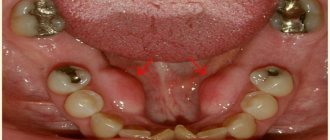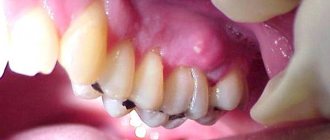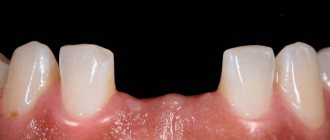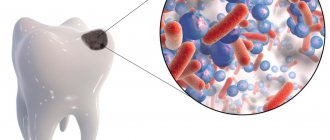Gum recession, causes and pathology photos
Let us consider in more detail what factors provoke gum recession - the reasons for its occurrence.
- Improper oral hygiene may well be the cause of this disease.
- The presence of tartar can cause displacement of the epithelium and expose the roots, which can provoke gum recession (photo below). Differential diagnostics show that such displacement most often occurs due to insufficient width of the gums and certain anatomical features of the gum structure.
- The resulting mechanical injury is what can start gum recession; the reasons may include various life circumstances and incorrect dental treatment.
- Age-related changes are also a fairly common cause of this disease.
Gum recession occurs quite often in dentistry; photos of this disease and its classification can be found on the Internet. A photo of the disease will help you notice the symptoms in time and seek help from a specialist. Further differential diagnosis, classification, as well as the use of plastic surgery or another method to stop the process is up to the dentist.
In simple words about a complex disease
What is gum recession? This is a pathology of the soft tissues of the oral cavity, which is characterized by a decrease in the mobile (marginal) level of the gum in the apical direction and exposure of the neck and root part of the teeth. Most medical reference books give approximately this definition. In simple terms, the gum literally moves down or up, exposing the tooth. Visually, this resembles low tide, when the water level decreases and the hitherto hidden relief of the coast appears.
Gum recession can occur at any age. However, the disease most often develops in people over fifty years of age. At this age, many patients experience loss of soft tissue edge height, but in most cases this is not very noticeable. The risk of a recession can be predicted. If the fixed and cervical parts of the gum are approximately equal in size, then the likelihood of recession is very high, since ideally the attached part of the gum should be much wider. It is also important to understand that in most cases, recession is a consequence of other diseases and pathological processes. This is why it is important to identify the root cause to create the optimal treatment plan.
Gum recession, disease classification
So, if differential diagnosis has established a diagnosis of “gingival recession,” the classification of this disease may be as follows:
- Class 1 - Recession that does not extend beyond the gum tissue.
- Class 2 - extends beyond the gum tissue, but bone loss is still not noticeable.
- Class 3 is a more severe form of the disease, which is accompanied by loss of intraproximal bone.
- Class 4 - loss of soft and bone tissue.
In the photos of different classification levels, you can assess the level of destruction of gum tissue.
If differential diagnosis has identified a disease within the classification of the first 2 classes, then an experienced specialist can completely close and stop this destructive process. But, if for some reason gum recession was not detected in a timely manner and its classification has exceeded the 3rd or 4th class, then it is no longer possible to close the process.
What is a recession?
Before going into the details of a recession in the economy, let's define what the word recession means and what it is. The word recession comes from the Latin recessus, which translated into Russian means “retreat.”
Speaking in relation to economics, it is important to understand that the economy is a fickle thing and all economic activity is subject to a certain cyclicality. An important feature of economic development is its cyclical nature, that is, the alternation of certain stages of development. So the concept of recession in the economy is easy to correlate with the economic cycle. If we talk about the economic cycle briefly, it includes 4 main phases - Growth, Stabilization (Stagnation), Recession and Crisis. Economic cycles vary in duration; we will talk about this in more detail some other time. Now let's get back to what a recession is.
Judging by the meaning of this word and the translation from Latin, as you probably already guessed, a recession in the economy corresponds to a slowdown in economic development and the beginning of a slight decline in production and a downturn in the economic cycle. However, recessions can be short-term or longer. So, a recession occurs only with a long-term and prolonged decline. If the main economic indicators decline for several months (about 6 months or more than 2 quarters in a row), we can definitely talk about a recession.
Due to its cyclical nature, a recession is inevitable at the macroeconomic level for any state, with any economic system.
In simple words, a recession is a long-term, at the first stage, insignificant decline in the economy (decline in production and general business activity), which intensifies over time and develops into a crisis. As a rule, during a recession there is a negative trend in GDP, reduced business activity, and a lack of growth and progress in the economic environment.
You can also often hear the concept of a technical recession. In a situation in the economy when the country's GDP growth rate has been declining for two quarters in a row, we can state the onset of a technical recession. In simple terms, a technical recession is a decline in GDP for two quarters in a row.
How to detect gum recession, differential diagnosis
In order to determine the classification of the disease, you must first identify the causes and make a diagnosis of “gum recession” - differential diagnosis takes place in several stages.
First, the specialist identifies complaints, after which he performs a visual examination. This is followed by laboratory recognition. The final stage, if a diagnosis of gum recession is suspected, differential diagnosis involves the use of technical equipment - X-rays, computed tomography, etc. Only after this the specialist prescribes objective treatment that will stop the development of the inflammatory process.
Causes of recession
A recession is a normal, albeit unpleasant, part of the economic cycle. Most often, the onset of a recession is provoked by crisis events in the economy and the stock market. This could be a financial crisis, a trade embargo, a shock to the demand or supply of goods, or the collapse of economic bubbles.
The global financial crisis of 2008-2009 brought attention to another problem that could lead to a recession. The globalization of the economy and the risky investment strategies of large financial institutions can lead to economic recession in almost all developed and developing countries of the world.
Typically, recessions last between 6 and 18 months, and interest rates typically fall during those months to stimulate the economy.
Plastic surgery of gum recession as a way to stop the disease
There are several ways to stop gum recession, one of which is gum grafting.
Gum recession plastic surgery is performed in several ways.
- The first method of plastic surgery is patchwork . This plastic comes in two types:
- A lateral flap is a gum recession repair that involves taking soft tissue from a donor tooth. Plastic can only be used if the required amount of soft tissue is available. The recession can only be stopped if a small area is affected.
- Palatal flap - this plastic surgery is somewhat inferior to the previous method in terms of aesthetic results, since the place of closure will differ in color even in a non-enlarged photo.
An option for laser patchwork is possible.
- The second method is plastic surgery of gum recession using resorbable membranes. You can stop gum recession by using:
- non-resorbable - those that are removed after treatment;
- resorbable - those that are completely implanted into the tissue.
- The third method is collagen plastic surgery. Collagen implants promote the regeneration of soft tissues; after the process can be stopped, the implants are removed.
Plastic surgery gives maximum effect in the early stages of the disease. Its results can be assessed from the photo.
Differences between recession and depression
A depression is a deep and prolonged recession.
Although there are no precise criteria for declaring a depression, features of the last depression in the United States, the Great Depression of the 1930s, included a decline in GDP of over 10% and an unemployment rate of 25%.
A common depression is a serious economic downturn that lasts several years.
Types of recessions
Recessions are usually classified according to the nature and periods of ups and downs in GDP. There are 4 types of recession:
- A V-shaped recession is characterized by a sharp drop in the level of GDP and a subsequent recovery to normal levels;
- A U-shaped recession differs from a V-shaped recession in that GDP remains at a low level for a long time. After some time, GDP recovers quickly;
- A W-shaped recession is characterized by an attempt to recover GDP in the middle of a recession. After an unsuccessful attempt, there is a new decline in GDP and subsequent recovery.
- An L-shaped recession is characterized by a sharp downward decline in GDP followed by a long and gradual recovery.
W and L-shaped recessions are the longest in duration. Often, economists tend to mistakenly consider the end of a long recession to be the beginning of a depression.
When can we expect a recession in Russia and is there one now?
To answer this question, it is necessary to correlate the main characteristic features of the recession with the economic situation that is currently happening in Russia.
As of September 2021, the situation in the Russian economy is very stable. We have one of the lowest unemployment rates in the history of modern Russia, as well as relatively low interest rates for our country at 7%. Despite the low GDP growth rates, the indicator itself shows versatile dynamics and has not had a negative downward trend for several quarters in a row.
There is also an official position represented by the Ministry of Economic Development, which states that a recession in Russia is possible only in 2021 . However, a number of experts from third-party structures and research centers suggest the possibility of a recession already in 2021, since Russia’s GDP fell sharply in the 1st quarter of 2021 (growth of only 0.5%) and increased slightly in the second quarter (growth of 0.9%). If GDP growth declines in the 3rd and 4th quarters, then we can talk about a technical recession. However, according to estimates in the 3rd quarter of 2021, Russia’s GDP is capable of growing to 1.7-1.8%, which will allow us to reach the projected annual GDP growth values of 1.1-1.3% at the end of 2021.
That is, at the moment there is no recession in Russia, but the situation may well worsen due to instability in global financial markets, trade wars, capital outflow, debt burden of the population and a bubble in the Russian lending market, as well as other external and internal factors.
Characteristics and signs of a recession
I have already listed the features and symptoms of a recession in part above, but let’s look at them again and summarize:
- GDP decline for 2 quarters in a row
- rising inflation, primarily rising prices for everyday products, and then for other goods
- reduction in loan size and decline in the total number of loans issued
- capital outflow abroad
- falling stock market indices, weakening of the national currency
- reduction in production volumes, with sufficient production
- job cuts and rising unemployment
- increase in state debt and overall debt burden of the population
It is important to understand that for a recession to occur, it is not always necessary to fulfill all the above-described signs. Often many indicators lag behind others and a recession is obvious when only a few of these indicators are detected.











